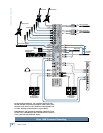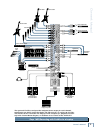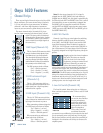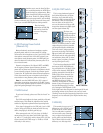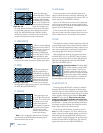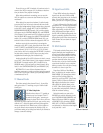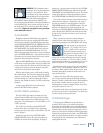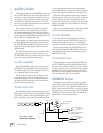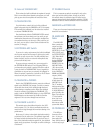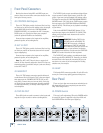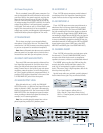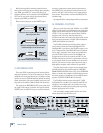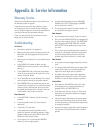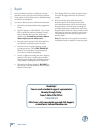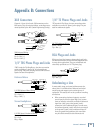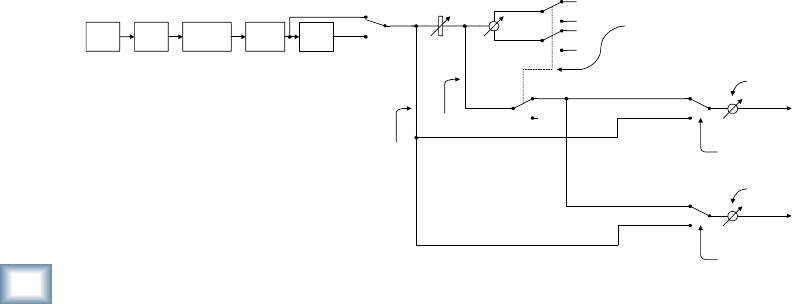
16
ONYX 1620
ONYX 1620
Auxiliary Section
This section includes the AUX MASTERS (Sends) and
the AUX RETURNS. These can be a bit confusing to the
uninitiated, so here’s the whole idea behind aux sends
and returns: sends are outputs and returns are inputs.
AUX SENDs tap signals off the channels, via the AUX
knobs (14), mix these signals together, then send them
out the AUX SEND jacks (50).
These outputs are fed to the inputs of an external
processor like a reverb or digital delay. From there,
the outputs of this external device are fed back to the
mixer’s AUX RETURN jacks (51). Then these signals are
sent through the AUX RETURN level controls (30), and
fi nally delivered to the MAIN MIX (38).
So, the original “dry” signals go from the channels to
the MAIN MIX and the affected “wet” signals go from
the AUX RETURNS to the MAIN MIX, and once mixed
together, the dry and wet signals combine to create a
glorious sound!
The AUX SENDS can also be used to provide another
mix for stage monitors, for example. In this case, the
AUX RETURNS aren’t used to return the signal. Instead,
they can be used as additional stereo inputs.
28. AUX 1 -4 MASTERS
The AUX MASTERS provide overall control over the
AUX SEND levels, just before they are delivered to the
AUX SEND outputs (50). These knobs go from off (∞)
to +15 dB when turned all the way up.
This is usually the knob you turn up when the lead
singer glares at you, points at his stage monitor, and
sticks his thumb up in the air. (It would follow that if
the singer stuck his thumb down, you’d turn the knob
down, but that never happens.)
29. AUX 1-4 PRE/POST
The PRE/POST switches determine whether the AUX
SEND signal is tapped from the channel before the fader
(pre-fader) or after the fader and MUTE button (post-
fader). Typically, you use a pre-fader send for monitors
so you can control the monitor levels independently
from the MAIN MIX. Use a post-fader send for effects, so
that the “wet” signal level follows the “dry” signal level.
Most other mixing consoles require you to assign the
pre/post function in pairs (Aux 1/2, Aux 3/4), which can
be very limiting if you want to provide three monitor
sends and one effects send, for example. The Onyx 1620
allows you to assign the pre/post function for each AUX
SEND individually.
Both pre- and post-fader sends are affected by the EQ
controls (unless the EQ is bypassed, of course).
30. AUX 1-4 RETURNS
These four controls set the overall level of effects
received from the stereo AUX RETURN 1-4 inputs (51).
These controls range from off (∞) to +10 dB of gain
when fully clockwise, to compensate for low-level effects.
Signals passing through the AUX RETURN level con-
trols proceed directly to the MAIN MIX bus where they
are combined with the other channels just before the
MAIN MIX fader (38).
31. FX TO MON Switch
This switch routes the signal from AUX RETURN 3 to
the AUX 1 SEND instead of the MAIN MIX bus. This al-
lows you to use an external effects device, like a reverb
or delay, exclusively for the monitors. When this switch
is pushed in, the effects signals coming into the AUX
RETURN 3 jacks are combined with the signals coming
from all of the channel AUX 1 send controls.
TALKBACK Section
The talkback feature allows the engineer to commu-
nicate with the talent either through the PHONES (24)
output or the AUX 1-2 (50) outputs. A talkback micro-
phone is built into the Onyx 1620, or you have the option
of connecting an external microphone at the TALKBACK
MIC XLR (47) connector on the rear panel, which may
be preferable in live or noisy situations.
GAIN INSERTLOW CUT EQ
EQ
IN/OUT
FADER
PAN
MUTE / ALT
AUX SEND 1 KNOB
"POST" SIGNAL
"PRE" SIGNAL
AUX SEND 2 KNOB
"POST" SIGNAL OBEYS
MUTE STATUS
INPUT
AUX SEND 2 PRE/POST SWITCH
(IN MASTER SECTION)
AUX SEND 1 PRE/POST SWITCH
(IN MASTER SECTION)
TO AUX SEND 1
OUTPUT
TO AUX SEND 2
OUTPUT
Aux “Pre vs. Post”
Signal Flow Diagram



